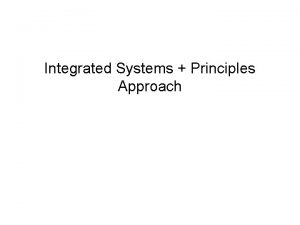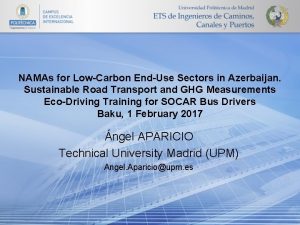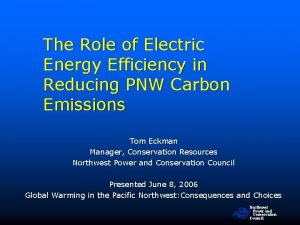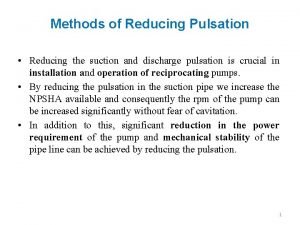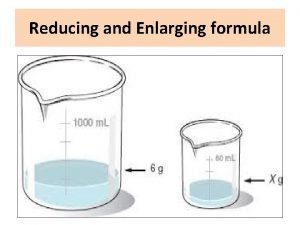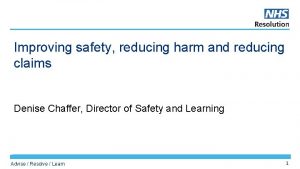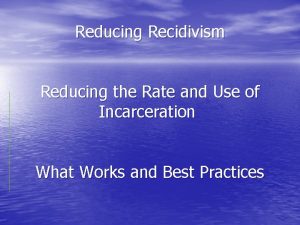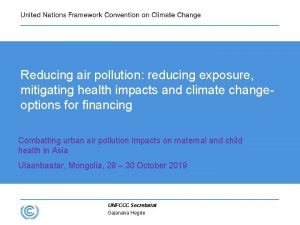The Role of Monitoring Energy EndUse in Reducing




































- Slides: 36

The Role of Monitoring Energy End-Use in Reducing Green House Gas Emission Ir Michael P K Cheung Energy Efficiency Office Electrical and Mechanical Services Department The Government of the HKSAR 1

HK Energy End-Use Database Natural Gas Oil 2 Imported Energy LPG Coal

HK Energy End-Use Database Objectives 3 Ø To provide the Government with energy end-use information Ø To assist the Government in the formulation and evaluation of energy efficiency programmes and policies

HK Energy End-Use Database Scope 4 Ø The Database covers internal civilian energy end-uses in Hong Kong. Ø It does not include energy exported, energy used for transportation between Hong Kong and foreign countries, Mainland, Macau & related areas and also energy used for military purposes etc.

HK Energy End-Use Database Structure 5 Ø 4 sectors (residential, commercial, industrial and transport) Ø 28 segments under the 4 sectors Ø 21 end-uses Ø 69 technologies (i. e. end-uses with different characteristics)

HK Energy End-Use Database Sector Segment Restaurant End-use Cooking Commercial Office Space conditioning Residential Lighting Industrial Health Hot water Transport 6 Technology cooking eqpt - electricity cooking eqpt. - town gas cooking eqpt. - LPG

HK Energy End-Use Database Approach 7 Ø Both top-down and bottom-up approaches are used Ø Top-down approach involves the use of available energy supply data from various major utilities. Ø Bottom-up approach involves estimating the number of units in each segment, the penetration of various energy end-uses and technologies and the annual energy consumption per unit for each technologies (the Energy Use Intensity (EUI)).

HK Energy End-Use Database Data Sources 8 Ø Publications from Census & Statistics Department Ø Data supplied by other relevant Government Departments (e. g. Transport Department, Ratings and Valuation Department) Ø Survey data collected by the consultants Ø Data collected from various utilities (e. g. CLP Power, HEC, railway companies, bus companies, ferry companies etc. )

HK Energy End-Use Database Total End-use Energy Consumption by Sectors (1994 – 2004) 36% 10% 36% 18% 9

HK Energy End-Use Database 2004 -Residential Energy End-uses(52041 TJ) 19% 12% 24% 22% 23% Cooking 10 Space conditioning Hot Water Lighting & Refrigeration Others

HK Energy End-Use Database 2004 -Commercial Energy End-uses(103646 TJ) 13% 40% 28% 4% Cooking 11 Space conditioning 15% Lighting Office Equipment Others

HK Energy End-Use Database 2004 -Transport Energy End-uses(102431 TJ) 31% 17% 35% Bus & Taxi 12 17% Car & Motorcycle Goods Vehicle Rail & Others

HK Energy End-Use Database 2004 Electricity End-use (141202 TJ) 30% 34% 3% Space conditioning 13 23% 3% 7% Lighting & Refrigeration Industrial Process / Equipment Cooking Hot Water Others

HK Energy End-Use Database Present Status & Future Development 14 Ø Updating of the Database Ø Energy Consumption Surveys Ø Handling Data Enquiry (http: //www. emsd. gov. hk)

Energy Consumption Indicators and Benchmarks Buildings A. B. C. D. Private Offices Commercial Outlets Hotels and Boarding Houses Universities, Post-secondary Colleges and Schools E. Hospitals and Clinics 15

Energy Consumption Indicators and Benchmarks Vehicles A. B. C. D. E. F. 16 Private Cars Light Goods Vehicles Medium Goods Vehicles Heavy Goods Vehicles Private Light Buses Non-Franchised Buses

Energy Consumption Indicators and Benchmarks Energy Consumption Indicators ® A quantitative measure of energy-use level ® e. g. MJ/m 2/annum Energy Consumption Benchmarks ® A comparison of energy consumption indicators ® e. g. 25 th percentile 17

Forming Sub-groups Multiple Tenants, with Central A/C Private Office Buildings 18 Multiple Tenants, without Central A/C Single Tenant, Whole Building Common Services & Tenants Consumption

Forming Sub-groups: Commercial Outlets in Shopping Centres Commercial Outlets Stand-alone Outlets 19

Main Deliverables Energy Consumption Indicators Benchmarking Ware 20 Recommendations

Primary and Secondary Indicators – Buildings ® Primary indicators: ® MJ/m 2/annum ® MJ/person/annum ® MJ/m 2/hour ® MJ/person/hour ® Secondary Indicators: ® Building related indicators, e. g. building age, floor area, weather (Non-manageable SIs) ® A/C temperature set-point, lighting type, occupant behaviour, maintenance practice (Manageable SIs) 21

Private Offices Energy consumed per unit floor area per year (MJ/m 2/annum) 1400 Energy consumption of tenant units Energy consumption of common services 1200 1000 800 600 400 200 0 Multiple tenants buildings with central A/C 22 Multiple tenants buildings without central A/C Single tenant whole building

Commercial Outlets Energy consumed per unit floor area per year (MJ/m 2/annum) 14000 Non-chinese restaurants Fast-food, bars, etc. 12000 Supermarkets 10000 General retail (food) 8000 General retail (non-food) 6000 Common Services (with A/C in common area) 4000 Common Services (no A/C in common area) 2000 0 23 Chinese restaurants Outlets in shopping centres Standalone Outlets

Major Factors Affecting Consumption ® Occupant behaviour ® Operating & maintenance practices ® Temperature set-point ® Type of A/C systems ® Type of lighting systems 24

Hong Kong Vs Asian Countries Private Office (Whole Building) Note: Data of other countries are from APEC Energy Benchmark System in 2000. 25

Potential Energy Savings 5% - 20% Improving O&M practices 26 Replacing Inefficient Equipment

Private Car Sub-groups & Segments ® Sub-groups n n n Under 1500 cc 1501 -2000 cc 2001 -2500 cc 2501 -3000 cc over 3000 cc ® Segments n n n 27 Hong Kong Island Kowloon New Territories

Survey 28

Primary and Secondary Indicators - Vehicles ® Primary indicators: ® Litres/100 km ® Annual average litres/person-km ® Secondary Indicators: ® Engine size, temperature, vehicle age, body type, transmission ® Others: mean speed by zone, average occupancy, awareness, etc. 29

Primary Indicator - Fuel Consumption 30

Regression Analysis ®Y = 1. 78 + 0. 00303 X 1 + 0. 168 X 2 + 1. 28 X 3 + 0. 105 X 4. . . Hong Kong Island Y = fuel consumption (l/100 km) X 1 = engine size (cc) X 2 = mean monthly temperature X 3 = body type (0 = saloon, 1 = all other types) X 4 = vehicle age (years) 31

Benchmarking Tool - Buildings Access through EMSD Website: http: //www. emsd. gov. hk 32

Benchmarking Tool - Vehicles Access through EMSD Website: http: //www. emsd. gov. hk 33

HK Energy End-Use Database Conclusion 34 Ø It can enable the Government to monitor and oversee the trend and developments in various energy end-use sectors Ø It facilitates the identification of the best areas for improving energy efficiency in Hong Kong

Indicators and Benchmarking Conclusion 35 Ø Enable users to benchmark their energy consumption with other similar premises in Hong Kong and to identify areas for improvement in energy efficiency. Ø Enable vehicle owners and drivers as well as fleet managers to benchmark the fuel consumption of their vehicles with other similar vehicles in Hong Kong. Ø The tool will raise public awareness in energy efficiency, make people more conscientious in using energy and contribute towards a reduction of green house gas emission in Hong Kong.

Thank You ! 36
 Reducing and non reducing sugar
Reducing and non reducing sugar Glycogen metabolism
Glycogen metabolism Iodine test reaction for carbohydrates
Iodine test reaction for carbohydrates Reducing vs non reducing sugar
Reducing vs non reducing sugar Energy energy transfer and general energy analysis
Energy energy transfer and general energy analysis Energy energy transfer and general energy analysis
Energy energy transfer and general energy analysis What is web role and worker role in azure
What is web role and worker role in azure Krappmann role taking
Krappmann role taking Role conflict occurs when fulfilling the role expectations
Role conflict occurs when fulfilling the role expectations Hát kết hợp bộ gõ cơ thể
Hát kết hợp bộ gõ cơ thể Bổ thể
Bổ thể Tỉ lệ cơ thể trẻ em
Tỉ lệ cơ thể trẻ em Chó sói
Chó sói Tư thế worms-breton
Tư thế worms-breton Chúa yêu trần thế
Chúa yêu trần thế Các môn thể thao bắt đầu bằng tiếng nhảy
Các môn thể thao bắt đầu bằng tiếng nhảy Thế nào là hệ số cao nhất
Thế nào là hệ số cao nhất Các châu lục và đại dương trên thế giới
Các châu lục và đại dương trên thế giới Công thức tiính động năng
Công thức tiính động năng Trời xanh đây là của chúng ta thể thơ
Trời xanh đây là của chúng ta thể thơ Cách giải mật thư tọa độ
Cách giải mật thư tọa độ Làm thế nào để 102-1=99
Làm thế nào để 102-1=99 Phản ứng thế ankan
Phản ứng thế ankan Các châu lục và đại dương trên thế giới
Các châu lục và đại dương trên thế giới Thơ thất ngôn tứ tuyệt đường luật
Thơ thất ngôn tứ tuyệt đường luật Quá trình desamine hóa có thể tạo ra
Quá trình desamine hóa có thể tạo ra Một số thể thơ truyền thống
Một số thể thơ truyền thống Cái miệng nó xinh thế chỉ nói điều hay thôi
Cái miệng nó xinh thế chỉ nói điều hay thôi Vẽ hình chiếu vuông góc của vật thể sau
Vẽ hình chiếu vuông góc của vật thể sau Nguyên nhân của sự mỏi cơ sinh 8
Nguyên nhân của sự mỏi cơ sinh 8 đặc điểm cơ thể của người tối cổ
đặc điểm cơ thể của người tối cổ Thế nào là giọng cùng tên
Thế nào là giọng cùng tên Vẽ hình chiếu đứng bằng cạnh của vật thể
Vẽ hình chiếu đứng bằng cạnh của vật thể Phối cảnh
Phối cảnh Thẻ vin
Thẻ vin đại từ thay thế
đại từ thay thế





































